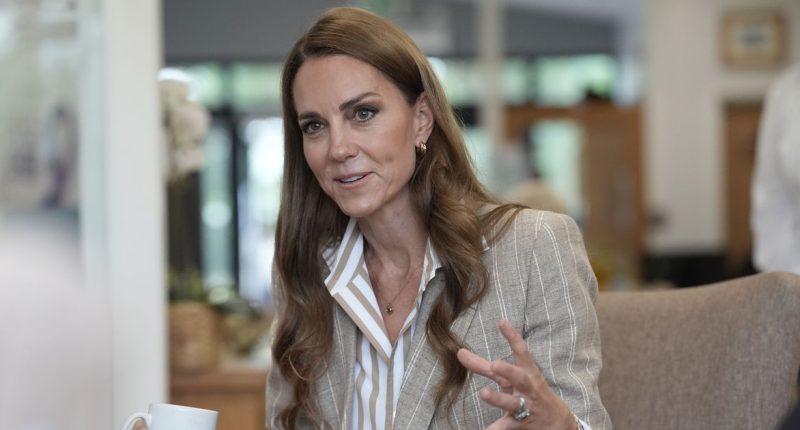After months away from the spotlight, Catherine, Princess of Wales, has returned to public life, making her first official appearance at the Trooping the Colour celebration in June. While her graceful presence reassured fans and well-wishers, the Princess offered a candid and emotional update on her ongoing health journey. Diagnosed with cancer earlier this year, Kate Middleton admitted that things are still “really difficult,” underlining the complexity of juggling recovery with royal obligations.
Her openness about her condition marks a significant shift in royal communication, moving toward a more transparent and relatable narrative. In doing so, she has not only sparked global support but also highlighted the very human side of public figures who often bear immense pressure behind closed doors.

What Kate Middleton Said About Her Health Struggles
In a rare personal statement released ahead of her public appearance, the Princess disclosed that she is still undergoing preventative chemotherapy. Her words revealed the physical and emotional challenges that accompany such a diagnosis. She described her situation as “a day at a time,” suggesting the uncertainty and unpredictability of cancer treatment.
Kate’s statement read in part:
“I’m making good progress, but as anyone going through chemotherapy will know, there are good days and bad days. On those bad days, you feel weak, tired and you have to give in to your body resting. But on the good days, when you feel stronger, you want to make the most of feeling well.”
That insight paints a vivid picture of what life looks like behind palace walls: not glittering banquets or diplomatic meetings, but quiet, determined healing.
Why Her Return Matters Beyond the Royal Family
The Princess’s reemergence resonates far beyond Kensington Palace. For many battling illness, especially cancer, her return represents hope, resilience, and the possibility of balancing professional life with recovery. By openly sharing her vulnerability, Kate is helping dismantle the stigma around serious illness.
Statistically, cancer affects 1 in 2 people in the UK during their lifetime, according to Cancer Research UK. Despite this prevalence, many feel isolated during treatment, a fact underscored by Kate’s own admission that the journey is “really difficult.”
Her choice to attend the Trooping the Colour—albeit for a limited time and with planned rest afterward—was a powerful gesture. It sent a message that strength isn’t always about pushing through but about knowing your limits, prioritizing your health, and still showing up when you can.
How the Public and Royals Have Reacted
The public response has been overwhelmingly supportive. Social media platforms were flooded with hashtags like #WelcomeBackCatherine and #RoyalStrength, with fans expressing admiration for her courage and composure. Even critics who typically view royal appearances with skepticism acknowledged the significance of her return.
Within the royal household, her decision to speak publicly has been met with respect. King Charles III, who is also undergoing treatment for cancer, has reportedly maintained close contact with her. Prince William, meanwhile, has adjusted his royal calendar to prioritize their family, showing solidarity and support for his wife.
This shared experience between the King and the Princess may subtly reshape how the Royal Family addresses health and personal vulnerability in the future.
Kate’s Message to Others Facing Illness
Perhaps the most impactful part of Kate’s update was her message to those facing similar health challenges. Without grandstanding or excessive sentimentality, she acknowledged the emotional toll illness can take—not just on the body but also on the mind.
She noted:
“To everyone who is facing this disease, in whatever form, please do not lose faith or hope. You are not alone.”
These words resonate deeply with cancer patients and survivors, offering comfort from someone who, despite her title, is walking a path familiar to millions.
The Reality of Balancing Royal Duties with Health Recovery
Being a working royal is far from symbolic. It involves daily briefings, public engagements, overseas travel, and a constant media presence. For someone in recovery, the expectations can feel particularly daunting.
Kate has wisely taken a flexible approach to her return:
- Attending only key events, such as the King’s birthday parade
- Delegating duties to other senior royals when needed
- Working remotely where possible
- Focusing on family time for emotional grounding
This approach reflects a growing recognition within royal circles that health and wellbeing should not be compromised for tradition. As the monarchy evolves, prioritizing wellness—even for its most visible members—might set a precedent for how institutions treat health crises in the modern age.
Looking Ahead: What This Means for the Future
Although the Princess has returned, it’s not a full-scale comeback. She has made it clear that her public appearances will be “sporadic” and dependent on how she feels. This realistic, unfiltered outlook not only protects her health but also shapes public expectations more sensibly.
In the long term, Kate’s story could inspire other institutions—both in government and business—to normalize recovery periods, especially for high-profile or high-pressure roles. Her resilience, while admirable, also underscores the importance of systemic support for those in treatment.
As for her royal role, many expect her influence to grow even stronger. Not just as a future Queen Consort, but as a compassionate advocate for cancer awareness, women’s health, and the importance of mental resilience.
Final Thoughts
Kate Middleton’s return to public duty—measured, brave, and honest—has struck a powerful chord with the public. Her health update serves as a reminder that even those in the highest offices can face overwhelming battles. Yet, through transparency, grace, and humility, she has transformed a personal struggle into a message of solidarity and strength.
Her journey continues, not just as a royal, but as a human being navigating illness with courage. And in doing so, she has redefined what it means to serve—with heart, honesty, and hope.
Also Read | How Teddi Mellencamp Is Fighting Cancer and Staying Positive









